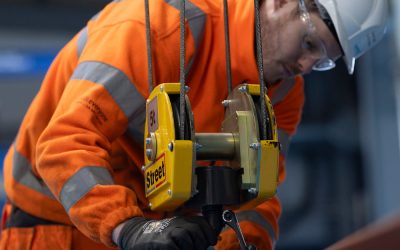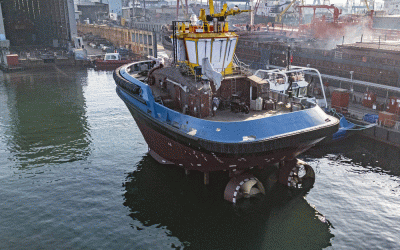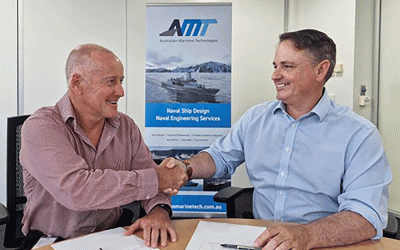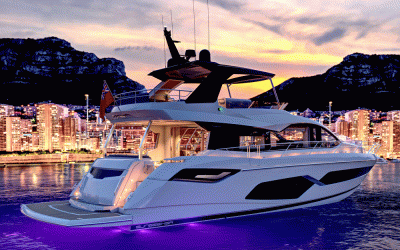If all goes to plan, the new year will see Stockholm welcome the first Candela P-12 foiling passenger shuttle – a city transport solution that promises zero emissions and extremely favourable efficiency gains compared to conventional diesel inland ferries.
For example, Candela claims, the 11.99m x 4.5m, 30-pax vessel will only require 44kW of engine power – thanks, in part, to the foils that will help it to glide across the water surface with reduced friction – compared to the 589kW typically demanded by a diesel boat.
Similarly, Candela predicts, while fuel and energy costs can amount to €90 per hour for a typical diesel-powered passenger boat, the P-12 should be able to slash this expenditure to €17 per hour – and that’s without taking its emission-free benefits into account. Designed for a range of 40-50nm, and incorporating 252kWh of batteries, the P-12 is expected to radically transform transport within Stockholm, to the extent of halving the times of certain journeys typically made by road.
One factor that may have been overlooked, however, is the application of composite materials in the vessel’s hull and hydrofoils. For this project, Candela returned to long-term partner Sicomin, which has supplied a complete package of epoxy resins and adhesives to the forthcoming carbon-fibre shuttle.
“We’ve been involved with Candela since day one,” Sicomin tells Ship & Boat International. “We worked on the very first project, the Candela C-7, which was launched in late 2016 – a key moment in Candela’s development of series-built, 100% electric foiling craft.” The 7.7m-long C-7 was followed by the 2023 commercial launch of the slightly larger, 8.5m C-8. “Materials have been constant throughout the development phase, with Candela very happy to continue with the same mix of infusion, laminating and bonding products across the range,” Sicomin adds.
The full carbon fibre and epoxy construction has led to the P-12 recording a weight of 9.5tonnes. “The P-12 has been developed using the same lightweight, infused-composite, foiling DNA for Candela’s C-7 and C-8 leisure craft, and is built using the same DNV-type approved Sicomin resins and adhesives as the previous models,” the company says.
“The Candela C-7 is around 50% lighter than a conventional ‘low-tech’ E-glass composite vessel,” Sicomin continues. “This low weight is what has allowed the Candela craft to carry the batteries that provide their range and performance.” Sicomin adds that its SR1710 epoxy infusion resin produces extremely high laminate mechanical properties which optimise performance in hot and wet conditions – and that this is a critical consideration for such a lightweight foiling craft. “SR1710 is optimised in terms of viscosity for wetting out carbon fibres in infusion,” says Sicomin. “These are much smaller than glass fibres, so there are smaller gaps in the dry fabric for the resin to flow through and ensure wet-out.
“We were asked by Candela to provide a liquid infusion system – as opposed to a prepreg material delivered frozen on a roll – to keep production costs at a more economical level, and with performance they could count on.”
The company’s epoxy adhesive Isobond SR7200HTG also features extensively in the construction of the P-12: used to bond the carbon fibre hull’s internal structure, and in final assembly of the vessel’s composite components. “SR7200HTG is suitable for both thick and thin bond lines [and] is particularly resistant to micro-cracking in long-term fatigue,” Sicomin says.
Despite its sleek, leisurely looks, the P-12 will face some gruelling routes. In this light, its epoxy adhesive’s resistance to micro-cracking becomes a crucial aspect. “Commercial traffic, such as short-transit ferry work within the city, will see the boats in much more constant use than, say, a recreational vessel,” Sicomin remarks. “This is primarily where the advantages become clear. Sicomin resins have a high thermal stability [Tg] and can therefore operate with batteries, charging systems and components running at temperature with no knock-down on their mechanical performance.
“This is also the case for fatigue performance – over an extended lifetime, the composite materials will be much more resistant to micro-cracking and degradation inside the composite laminate – what we could call an interlaminar shear failure. The same is also true for our Isobond SR7200HTG adhesive: it is optimised to maintain performance at higher operating temperatures which are, we understand, important with high-speed charging, small-scale packaging of electronic parts and the aim of keeping the vessel in use with minimal cooling periods.”




